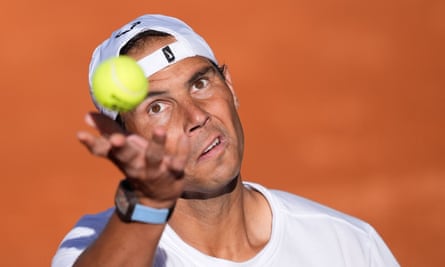Towards the end of last week, before most of the 192 players in the Madrid Open main draw singles had even touched down in the Spanish capital, Rafael Nadal was already pounding balls on the courts of the Caja Mágica in preparation for the coming tournament.
The four-time champion’s early arrival made sense. He is, after all, in a race against time to find at least a semblance of form before it’s too late. Not only is he tasked with somehow finding his feet after so many injuries, but this is it. Nadal may fast be approaching his endgame and he will likely compete at an ATP tournament on home soil for the final time in Madrid over the next two weeks. There will be no do-overs.
This season had started with far greater hopes for Nadal, who had returned to competition in the first week of the year after an 11 month layoff due to a hip injury. Even though he suggested that 2024 could well be his final season, the prospect of him returning healthy and in a rich vein of form was irresistible, a sentiment only bolstered by the way he rolled through his first two matches in Brisbane with ease.
But in his third match back, Nadal lost a brutal three hour, 24 minute match against Jordan Thompson, which included three squandered match points, and he suffered another hip injury. It has proven to a bitter reminder of how badly his body is struggling to deal with the demands of professional tennis after over two decades of play. Nadal missed another three months before returning last week in Barcelona, where he lost in the second round.
Having already withdrawn from Monte Carlo, it is clear that Nadal had run out of time for his preparations and he had to simply make do with what he had. Not only did he have minimal training hours behind him, but he has now had to adapt some of his strokes due to his physical ailments.
His serve is currently the most glaring weakness due to his lingering hip issues, which he has been careful not to aggravate. During most of the buildup to Barcelona, Nadal did not serve during his training sessions. He is now serving with minimal body rotation and the delivery is almost entirely driven by his arm.

“I haven’t been able to serve for a few months and, although I’m very excited, I’m not going to do things that are out of logic and serve like a crazy person. I have to serve with the caution that the moment dictates to me,” he said.
In his first round match there, Nadal blew away the young Italian Flavio Cobolli in straight sets but then against Alex de Minaur, the Australian’s ability to make it physical was fatal. After a competitive opening set, the Spaniard faded quickly, losing 7-5, 6-1. He later noted the task ahead as he tries to build his form.
“It wasn’t today that I had to give everything and die, I have to give myself the chance to do that in a few weeks, or at least try to. I will try to take a step further in Madrid, then another one in Rome and, in Paris … there is the moment to do it, whatever happens, there is no better place,” he said.
after newsletter promotion
This week in Madrid, the next step, Nadal has been offered a further reminder of his age before he even steps onto the court. In the first round, he will face Darwin Blanch, a 16-year-old wildcard, in the opening round of the tournament. The age gap of 21 years and 117 days is the biggest age gap in any Masters 1000 match since they began in 1990. After learning of his improbable impending match with Nadal, Blanch took to his Snapchat, covering his face with his hand in shock: “Guys I play Nadal,” he wrote.
For anyone else arriving in this shape in the final stretch, the odds would be heavily stacked against them. But this is Nadal on the surface he has dominated and transformed like no man before him, the owner of 14 Roland Garros titles with a ridiculous 112-3 (97%) win-loss record and 26 Masters 1000 titles. The last time he won Roland Garros, in 2022, he did so with a foot that had been deadened with a painkiller injection.
As the end of his career draws ever closer, Nadal will look to make one last miracle happen as he tries to build his fitness and form across the clay season before arriving at Roland Garros in strong enough shape to throw everything he has at the tournament one last time, and to die, figuratively, on the court. He will take his next step this week on home soil.
Source: theguardian.com


















